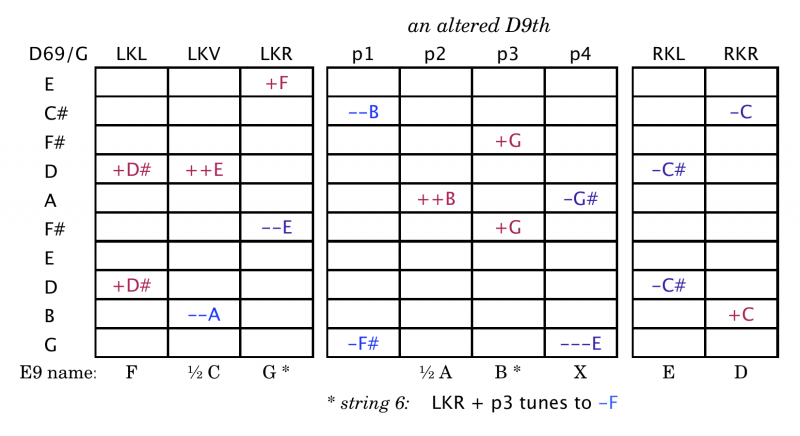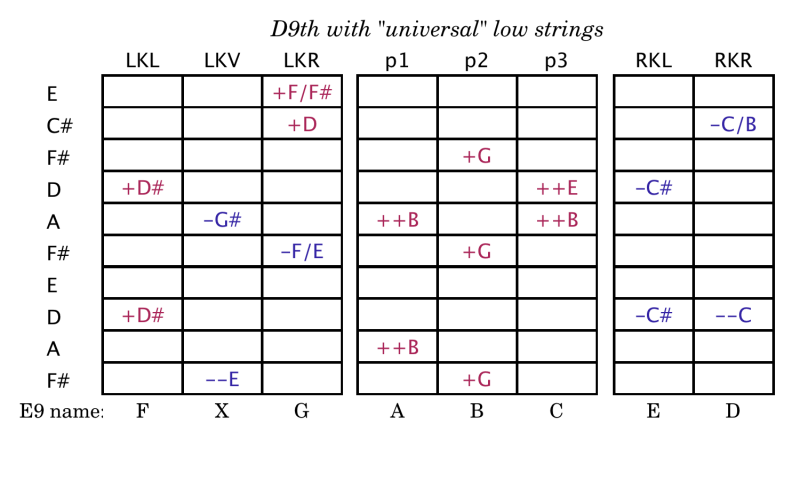Tuning down a step to D9th will give you more low end, but it doesn’t go as low as a standard 6-string guitar. Here’s what the “almost standard” E9th 3+5 changes look like dropped to D.

If you add the “Franklin” pedal, you’ll have a G on the 10th string. That’s close, but no cigar. If you’re like me, you really want that low E and don’t want to give up much to get it.
We can take a real good idea from the 8th and 9th strings of the C6th, which are tuned to A and F. If C6th were tuned D6th, those strings would be B and G. Putting those notes on our 9th and 10th string would mess up our “A” pedal, but it also gets us a step closer to that low E. I’ve read that Buddy Emmons sometimes disconnected that 10th string change anyway.
I have been experimenting with a Desert Rose S-10 4+5. Nice guitar! Before you freak out over the following chart, keep in mind that I have 4 decades of “muscle memory” that I want to retain. My personal quirks include 1) raising the 4th string on LKV instead of a “C” pedal, and 2) I don’t use a 2nd string half-stop. Your reflexes are probably different, and I won’t argue about that. I want to focus on how we can extend the range of the low 2 strings. First, retune strings 9 and 10 to B and G, respectively.

The 9th and 10th strings are now tuned C6th-style to B and G. Notice that the “X” lever change (my p4) is lowering the low G down to E. This is consistent with its use to get a 2 chord from the home position. Nailed it!
The 10th string “A” pedal change is now inverted on the 9th string. I still have the note, but I have to use my LKV to get it. Then I release it as I engage “A+B” to get that iconic 1 to 4 chord change in the low register. Also, the pedals down “A+B” position makes a full G6th tuning G B D E G B D just like a 7-string dobro.
The 9th string change on the “D” lever is also inverted. This is nice: the lever makes octave C notes on strings 2 and 9. It feels a lot like the Bb lever on C6th.
The low F# on the 10th string (my p1) just seemed like a good idea. It has a lot of uses. If you’ve followed me this far, you’ll figure it out.
But if I’ve lost you, here’s a solution that borrows from the U-12: eliminate the 9th string and add a low F# (G# on the U-12).

I don’t like that big interval between the 8th and 9th strings, though. I never warmed up to the U-12 concept for that reason. Thanks for following this to the end. Keep on Steelin’.
Visit our online Steel Guitar Shopper store for strings, equipment, music, instructional videos and materials, hard to find reference materials and rare items. https://www.steelguitarshopper.com/
Ten years ago I switched from a U-12 to a D-10. I missed the low range so much that I also changed to B & G# on strings 8&9 (A & F# on a D9) After a few months I lowered string 10 to an E. It felt more natural to have the root note on the bottom. The bottom three strings were E, B and E again. A very wide range, but try it, lower that string 10 and leave the pedals alone for now. If you are just as happy with it as I was, than the pedals will follow.
For me this is history, I am about to finish my D9th 12 string 🙂
I’m comfortable with a D tuning, Bas. I’ve been playing D6th for over 10 years now (with a low D root).
Ofcourse I know that, I was just considering the D69 as an alternative for my D6th witch I am bussy building right now.